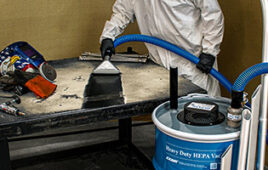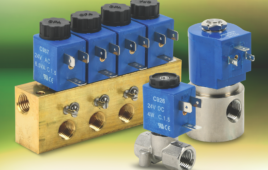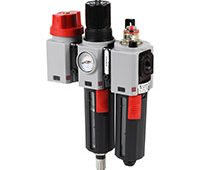New regulations restrict equipment leaks -— “fugitive emissions” — from production facilities. One key step is choosing ball valves that resist leaks.
Developed countries worldwide are focusing attention on fugitive emissions, equipment leaks to the outside environment.
Leaks may be either internal or external. For a ball valve, an internal leak could refer to a leak across the seat, from the upstream to the downstream side. So long as the valve does not vent to atmosphere, an internal leak would not result in fugitive emissions. By contrast, an external leak refers to a leak from inside the valve into the environment, for example, by way of the stem seal or body seal. To the extent that leaks pose harm to the environment, they are fugitive emissions.
To control fugitive emissions from ball valves, the key is to select the right valve. That requires a careful look at two design features: body seal design and stem seal design.
Body seal design
Two common types of body seals are screw type and flange type. While the screw type is a stronger seal, enabling higher system pressure, the flange type allows fast and easy maintenance with the valve in line, an important benefit.
The screw type consists of one or two threaded “end screws” that screw onto the body of the valve after the ball and seat packing have been loaded inside. The sealing area of a screw-type fitting is relatively small so it can be especially efficient, enabling effective sealing at pressures to 20,000 psig.
In valves employing the flange-type body seal, the valve body consists of three discrete sections that are joined together with flanges, seals, and bolts, as shown in the photo. Because the sealing area across these components is larger, this design usually results in a lower pressure rating. Since the flanges are sealed with gaskets, there are fewer geometric constraints on the sealing material, and therefore a wide choice of sealing materials is available.

Valves employing the flange type body seal consist of three discrete parts that are joined together with flanges, seals and long bolts. Such valves come apart for easy repair without need for removal.
The manufacturer’s standard sealing material is not always the answer, however. Take care to research sealing materials in conjunction with their system operating conditions, considering the full range of options, including metal gaskets, many different types of elastomer O-rings, and Grafoil packing, which may offer a more robust valve design. The bolts in the flange-type body seal should be of high grade material, such as strain hardened 316 stainless steel, to ensure sufficient sealing load is maintained.
An advantage of the flange-type design is the ease of maintenance. Once the bolts are removed, the valve’s body swings out for easy repair, eliminating the need to remove the entire valve from the system.
Stem design
The stem seal in a ball valve ensures that system media, whether liquid or gas, does not leak from the stem and body interface. Stem seals wear, and wear can lead to leakage. However, some seals are more effective than others for specific applications.
One-piece packing: The most basic technology is a one-piece gasket that encircles the stem. As the packing bolt is tightened down on the stem, the gasket, usually made of PTFE(polytetrafluoroethylene), is crushed, filling the space between the stem and the body housing.
Unfortunately, PTFE and other similar packing materials are subject to cold flow, which is the tendency for certain materials to change shape over time; cold flow can be exacerbated by pressure and temperature. In some cases, the material may extrude into areas where it was not intended to go, undermining its effectiveness and leading to leakage of system media.
To compensate for cold flow, the packing bolt may need to be tightened more frequently to increase the compression load on the stem seal, especially as application pressures and temperatures change and as the valve is repeatedly cycled.

Two different types of stem packing: standard one-piece packing, left; and chevron, right. In the chevron packing, minimal pressure from the packing nut pushes down on the two triangular shapes, resulting in outward, even pressure between the stem and the housing.
To reduce risk of fugitive emissions, the one-piece packing design should be reserved for applications where fluctuations in temperature and pressure will be minimal, where cycling will be limited, and where inspection and monitoring will be frequent and regular.
Two-piece chevron packing: This design is an improvement on the one-piece design, allowing for wider temperature and pressure ranges, as well as regular and easy actuation without excessive wear.
A chevron packing consists of two matched gaskets, one fitting inside the other, as shown. The cross-section of the gaskets is triangular in shape. Fitted together, the two gaskets form a rectangular cross section. As force is applied from the stem’s packing nut, the two gaskets are pushed against each other along the diagonal point where they meet, which sends the force horizontally and evenly against the stem and body housing. With minimal pressure from the packing nut, a substantial seal is created between the stem and the body housing.
For the chevron seal to work correctly, the two PTFE gaskets — the packing — must be held in place to reduce “cold flow” during thermal cycling. The packing in the chevron design, therefore, must be adequately contained and supported by packing support rings and glands, which evenly distribute pressure to the packing.
To reduce the interval of inspection and adjustment, the chevron design also may include Belleville washers, springs that create a “live load” on the packing. Live loading enables even pressure on the packing, as temperatures and pressures fluctuate. These springs provide a constant bias force against the seal and the body to ensure that the appropriate amount of sealing force is provided. At high temperature, the springs compress and allow space for the packing to expand. At low temperature, they expand and maintain the correct amount of pressure on the packing. The result is easy actuation and minimal wear to the packing.
O-ring seal: Another effective approach uses an O-ring design. When properly designed, this technology provides flexibility for applications requiring high pressure, low pressure, or a broad
pressure range, such as a cylinder, where, for example, pressure may drop from 2,300 psig when full to 100 psig as it nears empty.

Trunnion design keeps the ball centered and the stem properly aligned.
The O-ring is usually made from a highly elastic material, such as fluorocarbon FKM. The O-ring is energized by pressure in the media stream. As pressure in the stream increases, the O-ring further deforms and increases pressure on the stem. Conversely, as pressure in the gas stream decreases, the O-ring relaxes, filling the space between the stem and the body.
In terms of temperature, pressure, and chemical attack, the design is limited by the specifications of the elastomer. The key is understanding the system media and the potential for chemical interaction with the elastomer.
Stem misalignment
Additional causes of leaks may involve alignment of the stem. If the stem becomes tilted or forced to one side, there may be uneven wear to the stem seal, resulting in leakage. There are two basic causes of misalignment.

Cross section of a floating-ball valve in the shut position, with downstream pressure pushing the ball to seal on the right hand side. Arrows point to the seat seals.
First, misalignment may result from improper installation of the actuator. If the centerline of the actuator and the centerline of the stem are not properly aligned, the stem will become tilted or askew, resulting in uneven wear of the stem seal.
Second, damage to the seat seal inside the valve may cause the stem to tilt. A free-floating ball can be pushed downstream — too far downstream. In the absence of an advanced seat design — such as a spring energized seat, with an O-ring and spring on each side — the ball may not return to the center position. As a result, the stem will tilt to one side, and, with time, uneven stem wear will occur, as shown in the photo.
An alternative to the free-floating ball design is the trunnion design. Its geometry includes two cylinders — which are called the trunnions — affixed to the ball at the top and bottom. The unit fits into a space in the valve body and cannot move along the flow axis. As the ball rotates to the open and closed positions, it glides on the trunnions, which can be fitted with bushings or bearings. Even with a “hammer effect” — where a non-compressible medium, like water, produces a pressure spike — the trunnion design will keep the ball centered and the stem properly aligned, as shown.
Swagelok Co.
www.swagelok.com
::Design World::
Filed Under: Valves, FLUID POWER





Tell Us What You Think!